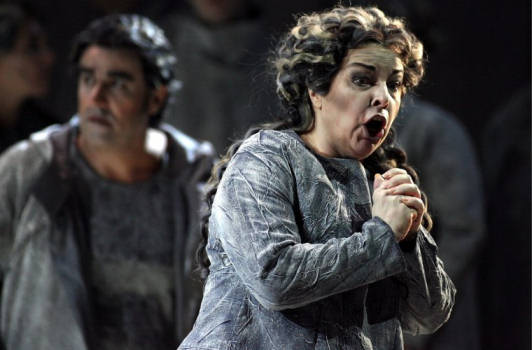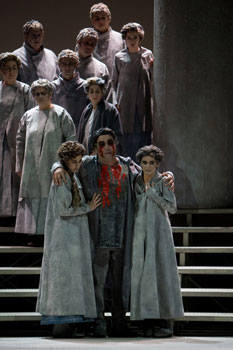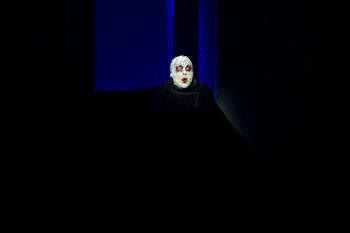Other Links
Editorial Board
- Editor - Bill Kenny
Founder - Len Mullenger
Google Site Search
SEEN
AND HEARD INTERNATIONAL OPERA REVIEW
Enescu, Oedipe
(Second Opinion)
: Soloists,
Orchestre du Capitole de Toulouse; Capitole Toulouse and Bordeaux
choruses. Conductor: Pinchas Steinberg. Théatre du Capitole de
Toulouse. 10.10.2008 (ED)
There is little doubt that Nicolas Joel’s enthusiasm for the opera
has been a driving force behind the new production. It was
therefore, a great concern to learn of his serious health
problems in the run-up to the premiere, knowing that such a complex
work to stage might suffer as a result. On the evidence of the
opening night it seems perhaps that things were pared back to make
the production reach the stage on schedule, and perhaps before it
transfers to Bucharest next September further elaboration of the
basic concept might take place. The direction of Act I (Oedipe’s
birth and the prophecy of his downfall) had stuttering moments and
Act II (the killing of Laios and the answering of the Sphinx’
riddle) had more of them as the transfer between scenes seemed a bit
hesitant. Acts III and IV (respectively, Oedipe learns that he
fulfilled the prophecies and blinds himself before taking refugein
old age within a sacred grove with
his daughter Antigone), being both single scene acts had a greater
degree of cohesion about them. The use of a single set, with slight
variations, simplified things rather on stage as well. The massed
crowd scenes of Acts I and III worked well, but the setting of Act
II, scene 2 where Oedipe kills his father at a crossroads was ill at
ease with the raked amphitheatre setting
in which it found itself.
The shepherd’s horrific observation that the King and his two
companions were killed also failed to correspond with the action,
with only Laios lying dead on stage. Some might also have wished for
greater colour contrast between the grey-taupe set and the costumes,
which tended to instil a sense of dry dustiness to the legend.
The real beneficiary of the production though was the music, and no
doubt as a conductor himself, Joel
realised that this is where the emphasis should be. There is after
all enough musical detail in Enescu’s score which deserves its
chance to be heard, and not become swamped by stage action. A huge
orchestra including additional piano, harmonium, celesta,
glockenspiel, alto saxophone - and
for purely dramatic effect also including
a musical saw, wind machine, whip on drum, pistol shot and
a nightingale’s song -
is employed, but all are used
with a great deal of restraint. This is further augmented by mixed
adult and children’s choruses to add specific textural nuances to
the narrative. If extravagance was ever a good thing in opera, and
surely it is here, then this and the consequent demands made must
account of the lack of productions. Pinchas Steinberg marshalled the
forces effectively, rarely letting the tension drop, though I felt
there were aspects of transition that had yet to be effectively
realised: from the sense of gloaming before the riddle of the
Sphinx, through the interrogation itself, to the euphoric Theban
celebrations afterwards. Cristian Mandeal (conductor of the
Edinburgh, Cagliari and Berlin productions) brought greater
instrumental drama and weight to Oedipe’s blinding in Act III, and
certainly a greater understanding of the Romanian folk elements that
pepper the score.

Sylvie Brunet as Jocasta
The work has had a patchy performance history to say the least. From
its world premiere in 1936 at the Palais Garnier in Paris, which the
composer described as being “like a dream” because no sooner had the
work been presented then it disappeared almost from view, concert
performances initially filled the void, including those in Belgium
in 1955, and more recently in Barcelona during 2003. The
British premiere of was given in concert at the 2002 Edinburgh
International Festival. Staged performances of the work have long
been a mainstay in Bucharest, understandably, but internationally
only a few provincial German houses mounted the work, albeit with
significant cuts to the score, until the Götz Friedrich
co-production between the Vienna State Opera and the Deutsche Oper
Berlin appeared in 1996. The Teatro Lirico di Cagliari mounted a
modern dress production by Graham Vick in 2005 as the Italian
premiere. This new co-production by Nicolas Joel between Toulouse
and the International Enescu Festival is further evidence that
Enescu’s mature compositions continue to gain serious attention
before the public.
There are
unconfirmed rumours that the production might be seen at the Palais
Garnier in Paris during the 2010-11
season, as Joel assumes control of Opéra
de Paris in September 2009.

Oedipe Blinded
Any slightly negative points though were amply balanced by other
factors in the production. Effective lighting, though sparingly
applied, added emphasis at key moments: the Sphinx rising from her
hell-red pit to have infinitely more menace than in the Cagliari
production; or the brilliant blue present almost throughout the
final Act. The crowd scenes were handled well: the sense of decay
and desolation that pervades Act III and its contrast with the
transformation of Oedipe in Act IV as he fearlessly follows the
calling of Eumenides to the afterlife were effectively communicated.

The Sphinx
Oedipe is on stage more or less throughout Acts II, III and IV, and
it is a demanding yet beautiful role to sing for an artist
who has the necessary vocal resources for
the task, which by and large Franck Ferrari does. There was a slight
tendency towards inaccuracy, particularly in Act III when quarter
and three-quarter tones are used to heighten the sense of anguish
and self-torment that Oedipe feels.
Ferrari's acting was purposeful
throughout, if occasionally lacking somewhat in impetus. Much of the
rest of the cast benefitted by being native French speakers. Vincent
Le Texier portrayed Creon somewhat as an opportunist
and Emiliano Gonzalez Toro was an effective shepherd, the one
character who pieces
together the action from birth predictions to witnessing their
fulfilment. Arutjun Kotchinian provided a rich and menacing Tiresias,
dominating as much by his stage presence as vocally. Amongst the
female cast, Sylvie Brunet provided a
strongly acted and vocally robust yet heart-moving Jocaste, charting
a path from serenity at her new birth to inner-most terror before
her suicide. Amel Brahim-Djelloul’s Antigone was a plaintive foil to
Oedipe in the final Act. Marie-Nicole Lemieux would have stolen the
evening for many though, in her
single scene as the Sphinx. Although restricted in movement by her
deathly-black costume she used the full extent of her supple
contralto to bring both haughtiness and harrowed agony in the
moments of her death, as Oedipe confidently declares that Man in
stronger than Destiny.
It is this message that makes the opera a truly universal one, its
point highly necessary now in today’s troubled world,
and thus making Enescu’s music more
relevant to audiences than ever before.
Youtube: Video about the production
Pictures © Théatre du Capitole de Toulouse
Back
to Top
Cumulative Index Page
